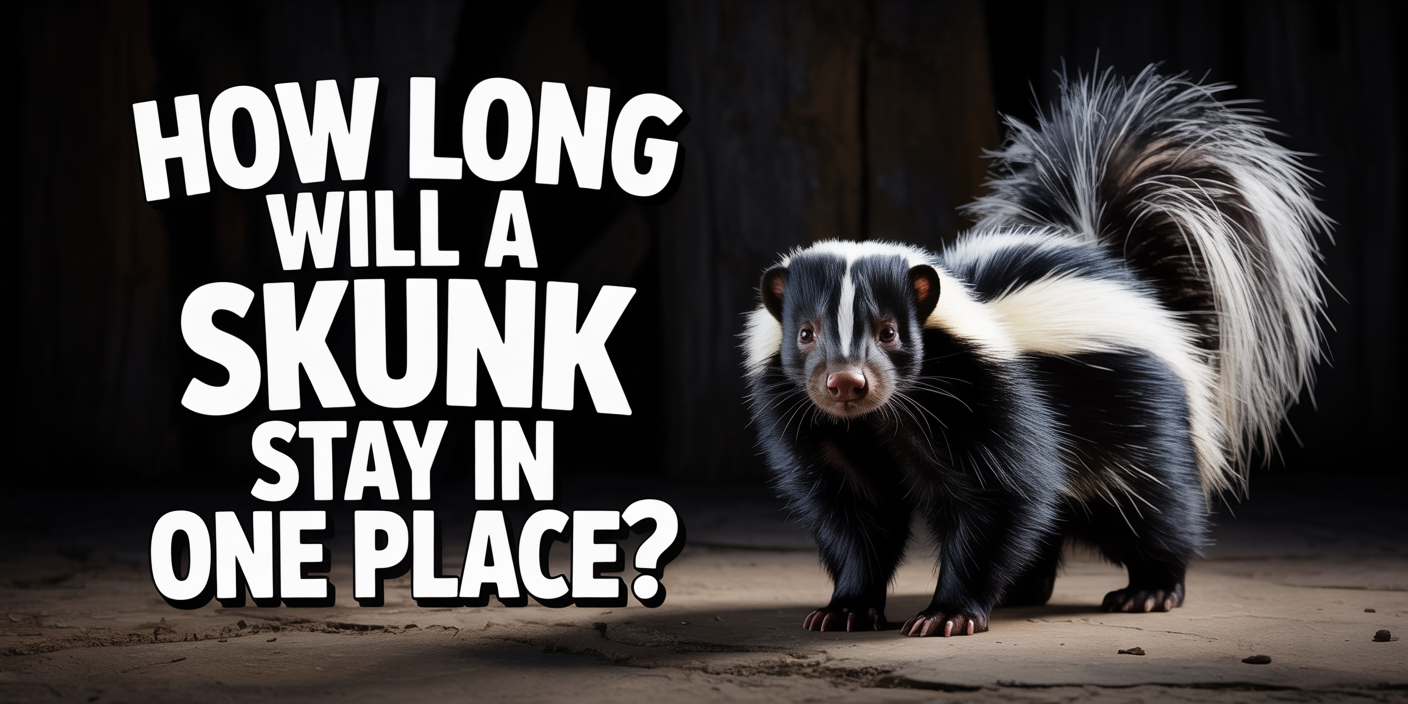“A skunk can stay in one place for just a night or as long as several months, depending on food, shelter, and the season.”
If you’ve spotted a skunk lingering around your yard or sneaking under your porch, you’re probably wondering how long that black-and-white visitor plans to stick around. The short answer—skunks may stay in one place for just a night, a few weeks, or even several months depending on the season and available shelter. If you’ve discovered a skunk in attic spaces or crawl areas, it likely means they’ve found a safe spot to sleep, raise young, or escape the weather, and they’re not always in a rush to leave.
At AAAC Wildlife Removal, we know firsthand that ignoring a skunk problem can lead to lingering odors, property damage, and even surprise encounters that nobody wants. That’s why understanding how long a skunk might stay is the first step toward protecting your home and yard. In this guide, we’ll walk you through skunk habits, how to spot signs they’ve settled in, and how our team helps homeowners get rid of skunks safely and efficiently.
Learn more: How do exterminators get rid of skunks?
How Long Do Skunks Typically Stay in One Place?
The amount of time a skunk stays in one location really depends on why it’s there. If a skunk is just passing through while foraging for food, it may only hang around for a night or two. These short-term visits are common in the warmer months when skunks roam in search of insects, fruits, and small prey.
On the other hand, skunks can take up residence for weeks or even months when they find an ideal denning spot. During colder seasons or when raising their young in spring, skunks often settle under decks, sheds, or crawlspaces to stay safe and warm. In suburban and rural areas where shelter is easy to find, skunks may treat your property like a long-term rental if left undisturbed.
What Makes a Skunk Settle in One Spot?
1. Food Sources Nearby
Skunks are driven by food availability. If your yard offers easy pickings like pet food left outside, overflowing trash cans, bird seed, or grub-rich lawns, they’re likely to stick around longer than just a night or two. Skunks are especially drawn to insect-rich soil, which is why you might notice small holes or patches of disturbed grass where they’ve been digging.
Once skunks realize your property provides consistent meals, that behavior becomes routine. You might not notice them every night, but they’ll return until that food source disappears. This is why AAAC Wildlife Removal advises homeowners to eliminate attractants before skunks make themselves too comfortable.
2. Shelter and Hiding Spots
Aside from food, skunks need safe shelter to rest, hide from predators, and escape harsh weather. Crawlspaces, decks, sheds, and woodpiles offer perfect hiding places. These locations keep them out of sight while giving easy access to surrounding food sources.
During colder months or the breeding season, these shelters become long-term homes. A skunk that finds a quiet, dry den spot could stay for several weeks or even months. That’s why AAAC Wildlife Removal specializes in locating and sealing off these entry points once skunks are removed.
3. Breeding and Raising Young
Spring is skunk baby season. Female skunks actively look for hidden, low-traffic spots to raise their kits from March through May. These dens aren’t temporary stopovers—once a mother skunk settles in, she’ll stay until her babies are strong enough to leave.
That means what started as a single skunk sighting can quickly turn into a full family situation. Property owners might hear scratching or squeaking sounds coming from under floors or decks during this period. AAAC Wildlife Removal has seen firsthand how fast skunk denning situations escalate, which is why early intervention is always recommended.
How Can You Tell If a Skunk Is Living on Your Property?
When a skunk decides to settle in one spot, it doesn’t always announce itself right away. While some signs are obvious, like the classic skunk smell, others are more subtle and easy to overlook until the problem grows. Spotting these indicators early makes all the difference when it comes to safe, humane removal.
Here are the most common signs a skunk is living on your property:
- Persistent Skunk Odor: A strong, lingering smell in one specific area rather than a one-time spray incident.
- Visible Skunk Tracks: Small paw prints with five toes, often seen in mud, dirt, or dusty areas.
- Digging and Lawn Damage: Small cone-shaped holes in the yard, a sign skunks are digging for grubs.
- Skunk Sightings: Regularly spotting skunks at dawn or dusk in the same location.
- Rustling or Scratching Sounds: Noises under decks, porches, or crawlspaces—especially in spring when raising kits.
If you notice any combination of these signs, AAAC Wildlife Removal recommends reaching out for a professional inspection before the situation becomes harder (and smellier) to handle.
What Happens If You Ignore a Skunk Problem?
Leaving a skunk problem unattended isn’t just about dealing with occasional bad smells. Over time, skunks can cause serious property damage by digging under foundations, tearing into ductwork, or disturbing insulation while creating a den. Their constant digging also damages lawns and gardens, especially if they’re searching for grubs or insects in your soil.
Ignoring skunks can also mean health and safety risks for both people and pets. Skunks can carry rabies, parasites, and diseases like leptospirosis. The longer they stay, the higher the chance of encountering them up close—something no one wants. That’s why AAAC Wildlife Removal always recommends proactive removal as soon as you notice signs of a skunk living nearby.
How Does AAAC Wildlife Removal Handle Skunk Removal?
1. Property Inspection and Assessment
Every skunk removal job starts with a detailed property inspection. AAAC Wildlife Removal’s trained specialists check for skunk dens, digging damage, tracks, and lingering odors to confirm active skunk presence. This step ensures we know exactly where the skunks are hiding before any trapping begins.
Our team also looks for potential entry points under decks, sheds, and crawlspaces. By identifying these vulnerable spots early, we can create a customized plan that tackles both removal and long-term prevention at the same time.
2. Identifying Skunk Entry Points and Den Sites
Beyond just spotting tracks and odor, we focus on locating where skunks are getting in and where they’ve established a den. Skunks prefer dark, enclosed spaces, and AAAC Wildlife Removal makes sure to check every likely spot thoroughly.
Understanding their specific den site location helps us avoid unnecessary disturbance to your property. It also ensures that traps are placed in the most effective spots, making removal faster and more efficient.
3. Safe and Humane Skunk Trapping
Once the assessment is complete, we set up humane traps specifically designed for skunks. These traps are placed strategically near den sites or along established travel routes skunks use regularly. The traps allow us to capture the skunk without harming it or releasing its defensive spray unnecessarily.
After trapping, our team carefully removes the skunk and follows all local wildlife regulations for relocation or handling. AAAC Wildlife Removal prioritizes safety, making sure there’s no mess or lingering odor left behind after the animal is removed.
4. Exclusion and Sealing of Access Points
After removal, we shift focus to preventing future skunk problems. AAAC Wildlife Removal seals off access points by installing barriers, hardware cloth, or other exclusion materials around decks, sheds, and foundation gaps. This step is essential for keeping new skunks from moving in.
We also provide homeowners with tailored recommendations, such as securing garbage cans, removing food attractants, and checking lawn conditions. Combining exclusion work with smart property maintenance helps keep your yard skunk-free for the long haul.
5. Follow-Up and Long-Term Prevention Tips
AAAC Wildlife Removal doesn’t just stop at removal—we offer follow-up visits to make sure everything stays skunk-free. Our team checks sealed access points, confirms there’s no new skunk activity, and ensures all preventive measures are holding up as intended.
Along with physical checks, we provide clients with practical long-term prevention tips. From advising on pet food storage to landscape changes that discourage digging, our focus is always on giving property owners peace of mind well after the skunks are gone.
How to Prevent Skunks from Staying on Your Property
Keeping skunks off your property is all about removing the things that attract them in the first place. By blocking off shelter spots and eliminating easy food sources, you can make your yard much less appealing to these animals. AAAC Wildlife Removal recommends taking these simple steps to avoid long-term skunk problems:
- Seal Off Entry Points: Close gaps under decks, sheds, and crawlspaces using hardware cloth or fencing to block access.
- Secure Trash and Food Sources: Use animal-proof trash cans with tight-fitting lids and avoid leaving pet food outdoors overnight.
- Remove Yard Attractants: Keep compost piles secured and clean up fallen fruits, bird seed, or other food sources in the yard.
- Repair Lawn Damage Promptly: Fill in holes or burrows that could be used as den sites or hiding spots.
- Install Exclusion Fencing: For larger properties, consider adding fencing designed to keep skunks out, especially around gardens or livestock areas.
By following these steps, you lower the chances of skunks settling in and help keep your property skunk-free without waiting for problems to show up.
Conclusion
A skunk might stay in one place for just a night—or it could settle in for months if your property offers food, shelter, and safety. The key is recognizing the signs early and addressing the situation before it turns into a long-term problem. From lingering odor to visible digging damage, small signs often point to a bigger issue waiting to happen.
That’s where AAAC Wildlife Removal comes in. Our team specializes in safe, humane skunk removal backed by thorough inspection, expert trapping, and effective exclusion work. If you suspect a skunk is living on your property, don’t wait it out—reach out to AAAC Wildlife Removal today and let us help you reclaim your space with peace of mind.




